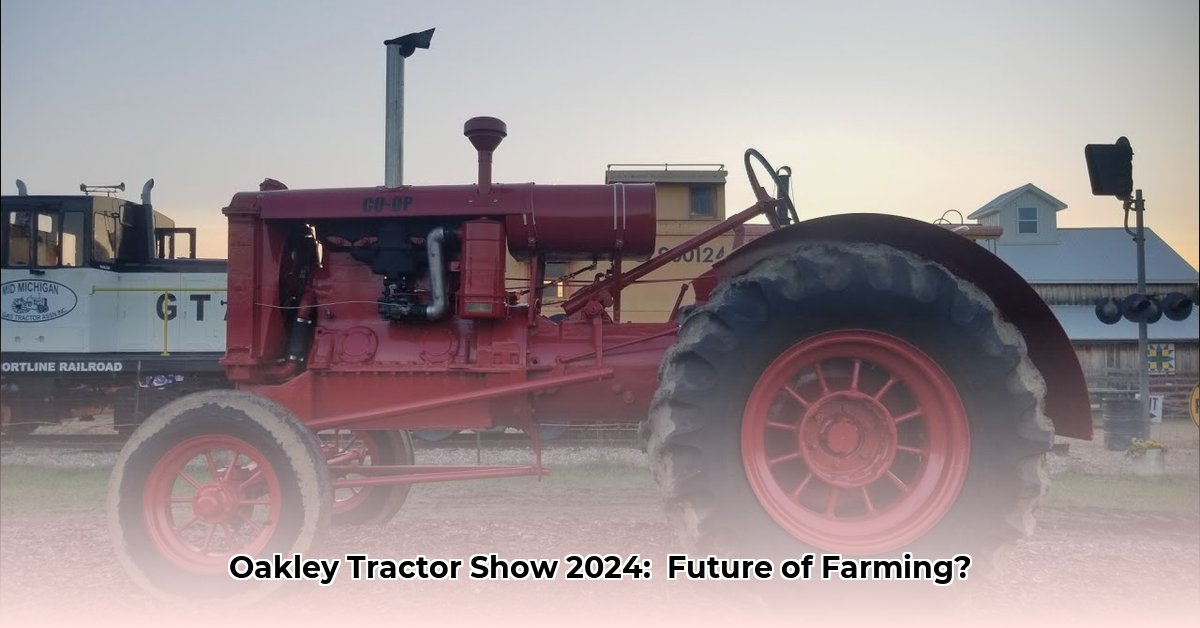
The Oakley Tractor Show 2024 wasn't your grandfather's agricultural exposition. Gone were the days of admiring solely the latest tractor models; this year's event was a vibrant showcase of the future of farming – a future defined by sustainable practices and cutting-edge technology. Precision agriculture, a smart approach to farming maximizing yields while minimizing environmental impact, took center stage. This report delves into the innovations displayed, their benefits for farmers and the planet, and the challenges inherent in their adoption. For those considering livestock integration, learn more about raising chickens. Whether you're a seasoned farmer or simply curious about the future of food production, this overview provides insights into the exciting advancements showcased at Oakley 2024.
Precision Agriculture: Farming Smarter, Not Harder
Imagine a farmer possessing precise knowledge of seed placement, fertilizer requirements for each field section, and optimal harvest timing for maximum yield. This isn't science fiction; it's the reality of precision agriculture. This approach leverages advanced technology and data analysis to optimize every farming stage. Instead of broadly applying pesticides across an entire field – potentially harming beneficial insects and wasting valuable resources – precision agriculture enables targeted application. This signifies less chemical runoff polluting waterways, reduced fertilizer waste, and healthier crops. It's a symbiotic relationship benefiting both farmers and the environment. The Oakley Tractor Show 2024 offered a prime opportunity to witness and even experience this transformative technology firsthand.
Smart Tech on Display: The Future is at Your Fingertips
The Oakley show floor buzzed with innovative tools designed for more efficient and profitable sustainable farming. Here's a glimpse of the showcased technologies:
Autonomous Tractors: These GPS-guided machines precisely plant seeds, apply pesticides (only where necessary!), and harvest crops, minimizing waste and maximizing yields. Think of them as highly skilled, tireless assistants working with unparalleled accuracy.
Variable-Rate Technology (VRT): This technology rejects the one-size-fits-all approach, enabling farmers to tailor their methods to each field area. Recognizing soil inconsistencies, VRT allows precise application of fertilizers, pesticides, and water, maximizing resource efficiency.
Drone Technology and Remote Sensing: Imagine tiny flying robots constantly monitoring crop health. These drones capture detailed images and data, providing insights into crop health, stress levels, and potential problems. Early problem detection allows for timely intervention, preventing significant losses. This real-time monitoring significantly enhances decision-making capabilities.
Data Analytics & Farm Management Software: Modern farming generates significant data. This software interprets this data, providing clear, actionable recommendations for farmers. It's like having a dedicated farm expert working around the clock, optimizing every decision from planting to harvest.
Benefits Beyond the Bottom Line: A Healthier Planet, Too
The advantages of precision agriculture extend far beyond increased profits. It represents a fundamental shift towards more sustainable agricultural practices.
Advantages:
Increased Yields: Optimized resource allocation directly translates into larger, healthier harvests, providing more food for a growing global population.
Reduced Input Costs: Less fertilizer, water, and pesticide use lead to significant cost savings for farmers, enhancing the sustainability and resilience of farming businesses.
Decreased Environmental Impact: Targeted input application minimizes pollution and protects ecosystems, contributing to cleaner water and healthier soil.
Improved Decision-Making: Data-driven insights eliminate guesswork, resulting in more informed and efficient farming practices. Farmers transition from reactive to proactive management.
Disadvantages:
High Upfront Investment: Implementing these technologies requires a substantial initial investment; however, the long-term cost savings often outweigh this initial outlay.
Technical Expertise: Farmers require training and support to effectively utilize these sophisticated systems. Fortunately, various resources are available to facilitate this learning process.
Data Security: Protecting sensitive farm data is crucial. Robust security measures are essential to prevent unauthorized access and data breaches. This is a persistent concern requiring ongoing attention in the field.
Interoperability Issues: Different systems may not always seamlessly communicate. The industry is actively working to improve interoperability, enabling farmers to readily integrate various technological tools.
Oakley 2024: More Than Just a Show – A Collaborative Effort
The Oakley Tractor Show 2024 wasn't merely a technology showcase; it fostered collaboration, uniting farmers, researchers, and technology providers to address challenges and share best practices. Discussions concerning affordability, training, and data management were central to the event, ensuring that these groundbreaking technologies are accessible to all, regardless of farm size or expertise. The future of farming hinges on accessibility and collaboration, and the Oakley show actively promoted both.
How to Overcome Challenges Implementing Precision Agriculture in Developing Countries
This year's Oakley Tractor Show highlighted innovative solutions tackling the implementation hurdles of precision agriculture in developing nations. It wasn't simply about advanced machinery; it focused on bridging the gap between cutting-edge technology and the realities of farming in resource-constrained environments.
Key Strategies for Success:
Affordable Technology: Developing and deploying cost-effective tools is paramount for wider adoption in developing countries.
Education & Training: Investing in farmer education and digital literacy is equally important as the technology itself.
Context-Specific Solutions: Precision agriculture solutions require adaptation to local farming practices and environmental conditions.
Collaboration: Partnerships between stakeholders (farmers, researchers, governments, NGOs) are crucial for success.
Financial Support: Access to finance is essential for farmers to acquire necessary technology.
Risk Mitigation Strategies
Implementing precision agriculture involves risks. The Oakley show emphasized the importance of a risk assessment matrix for effective management:
| Technology/Approach | High Risk Factors | Mitigation Strategies |
|---|---|---|
| AI-driven yield prediction | Data bias, model accuracy, over-reliance on predictions | Rigorous data validation, model transparency, human oversight |
| IoT sensors | Data security breaches, equipment failure, high initial cost | Robust cybersecurity protocols, redundancy systems, subsidized access |
| Drone imagery | Privacy concerns, regulatory hurdles, weather dependency | Compliance with data privacy regulations, alternative data sources, weather-resilient planning |
| Data-driven decision support | Data overload, lack of technical expertise, implementation challenges | User-friendly interfaces, extensive training programs, phased implementation |
The Oakley Tractor Show 2024 planted the seeds for a sustainable future in agriculture. It serves as a powerful reminder of the transformative potential of technology combined with collaborative efforts to address global food security challenges.